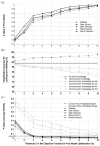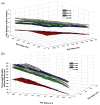Toward design of an environment-aware adaptive locomotion-mode-recognition system
- PMID: 22996721
- PMCID: PMC3718467
- DOI: 10.1109/TBME.2012.2208641
Toward design of an environment-aware adaptive locomotion-mode-recognition system
Abstract
In this study, we aimed to improve the performance of a locomotion-mode-recognition system based on neuromuscular-mechanical fusion by introducing additional information about the walking environment. Linear-discriminant-analysis-based classifiers were first designed to identify a lower limb prosthesis user's locomotion mode based on electromyographic signals recorded from residual leg muscles and ground reaction forces measured from the prosthetic pylon. Nine transfemoral amputees who wore a passive hydraulic knee or powered prosthetic knee participated in this study. Information about the walking terrain was simulated and modeled as prior probability based on the principle of maximum entropy and integrated into the discriminant functions of the classifier. When the correct prior knowledge of walking terrain was simulated, the classification accuracy for each locomotion mode significantly increased and no task transitions were missed. In addition, simulated incorrect prior knowledge did not significantly reduce system performance, indicating that our design is robust against noisy and imperfect prior information. Furthermore, these observations were independent of the type of prosthesis applied. The promising results in this study may assist the further development of an environment-aware adaptive system for locomotion-mode recognition for powered lower limb prostheses or orthoses.
Figures





Similar articles
-
Investigation of Timing to Switch Control Mode in Powered Knee Prostheses during Task Transitions.PLoS One. 2015 Jul 21;10(7):e0133965. doi: 10.1371/journal.pone.0133965. eCollection 2015. PLoS One. 2015. PMID: 26197084 Free PMC article.
-
Continuous locomotion-mode identification for prosthetic legs based on neuromuscular-mechanical fusion.IEEE Trans Biomed Eng. 2011 Oct;58(10):2867-75. doi: 10.1109/TBME.2011.2161671. Epub 2011 Jul 14. IEEE Trans Biomed Eng. 2011. PMID: 21768042 Free PMC article.
-
Development of an Environment-Aware Locomotion Mode Recognition System for Powered Lower Limb Prostheses.IEEE Trans Neural Syst Rehabil Eng. 2016 Apr;24(4):434-43. doi: 10.1109/TNSRE.2015.2420539. Epub 2015 Apr 14. IEEE Trans Neural Syst Rehabil Eng. 2016. PMID: 25879962
-
Noninvasive Human-Prosthesis Interfaces for Locomotion Intent Recognition: A Review.Cyborg Bionic Syst. 2021 Jun 4;2021:9863761. doi: 10.34133/2021/9863761. eCollection 2021. Cyborg Bionic Syst. 2021. PMID: 36285130 Free PMC article. Review.
-
Relying on more sense for enhancing lower limb prostheses control: a review.J Neuroeng Rehabil. 2020 Jul 17;17(1):99. doi: 10.1186/s12984-020-00726-x. J Neuroeng Rehabil. 2020. PMID: 32680530 Free PMC article. Review.
Cited by
-
Terrain Feature Estimation Method for a Lower Limb Exoskeleton Using Kinematic Analysis and Center of Pressure.Sensors (Basel). 2019 Oct 12;19(20):4418. doi: 10.3390/s19204418. Sensors (Basel). 2019. PMID: 31614811 Free PMC article.
-
The Role of Surface Electromyography in Data Fusion with Inertial Sensors to Enhance Locomotion Recognition and Prediction.Sensors (Basel). 2021 Sep 19;21(18):6291. doi: 10.3390/s21186291. Sensors (Basel). 2021. PMID: 34577498 Free PMC article.
-
Review on Portable-Powered Lower Limb Exoskeletons.Sensors (Basel). 2024 Dec 18;24(24):8090. doi: 10.3390/s24248090. Sensors (Basel). 2024. PMID: 39771825 Free PMC article. Review.
-
Investigation of Timing to Switch Control Mode in Powered Knee Prostheses during Task Transitions.PLoS One. 2015 Jul 21;10(7):e0133965. doi: 10.1371/journal.pone.0133965. eCollection 2015. PLoS One. 2015. PMID: 26197084 Free PMC article.
-
Environment Classification for Robotic Leg Prostheses and Exoskeletons Using Deep Convolutional Neural Networks.Front Neurorobot. 2022 Feb 4;15:730965. doi: 10.3389/fnbot.2021.730965. eCollection 2021. Front Neurorobot. 2022. PMID: 35185507 Free PMC article.
References
-
- Au S, Berniker M, Herr H. Powered ankle-foot prosthesis to assist level-ground and stair-descent gaits. Neural Netw. 2008;21:654–66. - PubMed
-
- Suzuki K, Mito G, Kawamoto H, Hasegawa Y, Sankai Y. Intention-based walking support for paraplegia patients with Robot Suit HAL. Adv Robot. 2007;21:1441–1469.
-
- Tsukahara A, Kawanishi R, Hasegawa Y, Sankai Y. Sit-to-stand and stand-to-sit transfer support for complete parapledgic patients with robot suit HAL. Adv Robot. 2010;24:1615–1638.
-
- Dollar A, Herr H. Lower extremity exoskeletons and active orthoses: Challenges and state-of-the-art. IEEE Trans Robot. 2008 Feb;24(1):1–15.
Publication types
MeSH terms
Grants and funding
LinkOut - more resources
Full Text Sources
Medical

